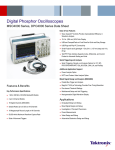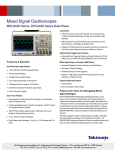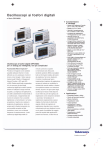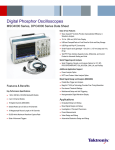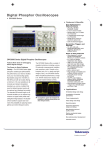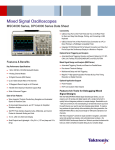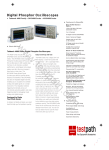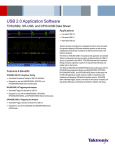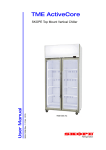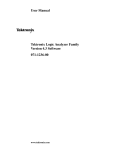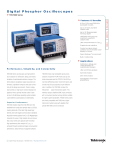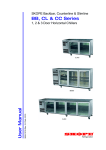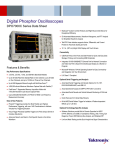Download Digital Phosphor Oscilloscopes
Transcript
Complimentary Reference Material This PDF has been made available as a complimentary service for you to assist in evaluating this model for your testing requirements. TMG offers a wide range of test equipment solutions, from renting short to long term, buying refurbished and purchasing new. Financing options, such as Financial Rental, and Leasing are also available on application. TMG will assist if you are unsure whether this model will suit your requirements. Call TMG if you need to organise repair and/or calibrate your unit. If you click on the “Click-to-Call” logo below, you can all us for FREE! TMG Corporate Website TMG Products Website Disclaimer: All trademarks appearing within this PDF are trademarks of their respective owners. Form 080/01 Digital Phosphor Oscilloscopes DPO4000 Series Features & Benefits 1 GHz, 500, 350 MHz Bandwidth Models 2 and 4 Channel Models Sample Rates Up to 5 GS/s on All Channels 10 Megasample Record Length on All Channels Wave Inspector Controls Provide Unprecedented Efficiency in Waveform Analysis I2C, SPI, CAN Serial Triggering and Analysis 10.4 in. (264 mm) XGA Color Display Small Footprint and Lightweight – Only 5.4 in. (137 mm) Deep and 11 lbs. (5 kg) USB and CompactFlash on Front Panel for Quick and Easy Storage Built-in Ethernet Port DPO4000 Series Digital Phosphor Oscilloscopes: Debug Smarter, Not Harder! Wave Inspector Controls Imagine trying to efficiently use the Internet if search engines such as Google and Yahoo didn’t exist, Web browser features such as Favorites and Links didn’t exist or Internet Service Providers like AOL or MSN weren’t around. Now you know how most modern oscilloscope users feel when trying to actually use the long record length in their digital oscilloscope. Record length, one of the key specifications of an oscilloscope, is the number of samples it can digitize and store in a single acquisition. The longer the record length, the longer the time window you can capture with high resolution (high sample rate). The first digital oscilloscopes could capture and store only 500 points which made it very difficult to acquire all relevant information around the event being investigated. Over the years, oscilloscope vendors have provided longer and longer record lengths to meet market demands for long capture windows with high resolution to the point that most mid-range oscilloscopes either come standard with, or can be optionally upgraded to, multi-mega-point record lengths. These mega-point record lengths often represent thousands of screens worth of signal activity. While standard record lengths have increased greatly over the years and can now satisfy the vast majority of applications in the marketplace, tools for effectively and efficiently viewing, navigating and analyzing long record length acquisitions have been sorely neglected until now. The DPO4000 Plug ‘n’ Play Connectivity and Analysis Software Solutions USB 2.0 Device Port for Direct PC Control of Oscilloscope Using USBTMC Suite of Advanced Triggers e*Scope® Remote Viewing and Control Interoperability with Tektronix Logic Analyzers TekVPI™ Probe Interface Supports Active, Differential and Current Probes for Automatic Scaling and Units Applications Embedded Design and Debug Investigation of Transient Phenomena Power Measurements Video Design and Debug Spectral Analysis Automotive Electronics Design and Debug Manufacturing Test and Quality Control Electro-mechanical Design and Analysis Bio-medical Product Development Industrial Control Digital Phosphor Oscilloscopes DPO4000 Series Wave Inspector Controls provide unprecedented efficiency in viewing, navigating and analyzing waveform data. Series redefines expectations for working with long record lengths with the following innovative new Wave Inspector controls (above and center): Zoom/Pan – A dedicated, two-tier frontpanel knob provides intuitive control of both zooming and panning. The inner knob adjusts the zoom factor (or zoom scale); turning it clockwise activates zoom and goes to progressively higher zoom factors, while turning it counter-clockwise results in lower zoom factors and eventually turning zoom off. The outer knob pans the zoom box across the waveform to quickly get to the portion of the waveform you are interested in. The outer knob also utilizes force-feedback to determine how fast to pan on the waveform. The farther you turn the outer knob, the faster the zoom box moves. Pan direction is changed by simply turning the knob the other way. No longer do you need to navigate through multiple menus to adjust your zoom view. 2 Setup and Hold search highlighting numerous setup and hold violations in a single acquisition. Play/Pause – A dedicated play/pause button on the front panel scrolls the waveform across the display automatically while you look for anomalies or an event of interest. Playback speed and direction are controlled using the intuitive pan knob. Once again, turning the knob further makes the waveform scroll faster and changing direction is as simple as turning the knob the other way. User Marks – See something interesting on your waveform? Press the Set Mark button on the front panel to leave one or more “bookmarks” on the waveform. Navigating between marks is as simple as Oscilloscope • www.tektronix.com/oscilloscopes pressing the Previous and Next buttons on the front panel. Search Marks – Don’t want to take the time to inspect the entire acquisition to find the event you’re looking for? The DPO4000 Series features a robust waveform search feature that allows you to search through your long acquisition based on user-defined criteria. All occurrences of the event are highlighted with search marks and are easily navigated to, using the front panel Previous and Next buttons. Search types include edge, pulse width, runt, logic, setup and hold, rise/fall time and I2C, SPI and CAN packet content. Digital Phosphor Oscilloscopes DPO4000 Series Serial Triggering and Analysis One of the most common applications requiring long record length is serial data analysis in embedded system design. Embedded systems are literally everywhere. They can contain many different types of devices including microprocessors, microcontrollers, DSPs, RAM, EPROMs, FPGAs, A/Ds, D/As and I/O. These various devices have traditionally communicated with each other and the outside world using wide parallel buses. Today, however, more and more embedded systems are replacing these wide parallel buses with serial buses due to less board space required, fewer pins, lower power, embedded clocks, differential signaling for better noise immunity, and most importantly, lower cost. In addition, there’s a large supply of off-the-shelf building block components from reputable manufacturers, enabling rapid design development. While serial buses have a large number of benefits, they also present significant challenges that their predecessors (parallel buses) did not face. They make debugging bus and system problems more difficult, it’s harder to isolate events of interest and it’s more difficult to interpret what is displayed on the oscilloscope screen. The DPO4000 Series addresses these problems and represents the ultimate tool for engineers working with low-speed serial buses such as I2C, SPI and CAN. Bus Display – Provides a higher level combined view of the individual signals (clock, data, chip enable, etc.) that make up Triggering on specific data packet going across an I2C bus. Yellow waveform is data, blue waveform is clock. Bus waveform provides decoded packet content including Start, Address, Read/Write, Data, Missing Ack and Stop. your bus, making it easy to identify where packets begin and end and identifying sub-packet components such as address, data, identifier, CRC, etc. Serial Triggering – Trigger on packet content such as start of packet, specific addresses, specific data content, unique identifiers, etc., on popular low-speed serial interfaces such as I2C, SPI and CAN. Bus Decoding – Tired of having to visually inspect the waveform to count clocks, determine if each bit is a 1 or a 0, combine bits into bytes and determine the hex value? Let the oscilloscope do it for you! Once you’ve set up a bus, the oscilloscope will decode each packet on the bus, and display the value in either hex or binary in the bus waveform. Packet Decode Table – In addition to seeing decoded packet data on the bus waveform itself, you can view all captured packets in a tabular view much like you would see on a logic analyzer. Packets are listed consecutively with columns for each component (Address, Data, etc.). Oscilloscope • www.tektronix.com/oscilloscopes 3 Digital Phosphor Oscilloscopes DPO4000 Series Search – Serial triggering is very useful for isolating the event of interest, but once you’ve captured it and need to analyze the surrounding data, what do you do? In the past, users had to manually scroll through the waveform counting and converting bits and looking for what caused the event. With the DPO4000 Series, you can have the oscilloscope search through the acquired data for user-defined criteria including serial packet content. Each occurrence is highlighted by a search mark. Rapid navigation between marks is as simple as pressing the Prev and Next buttons on the front panel. The Performance and Feature Set You Expect The DPO4000 Series digital phosphor oscilloscopes (DPO) deliver the performance you need to visualize even your most demanding signals. Bandwidths range from 350 MHz to 1 GHz, and with all models offering a minimum of 5x oversampling on all channels and sin(x)/x interpolation standard, you can be confident that even the fastest transient events will be captured and displayed accurately. The standard 10 M record length on all channels enables you to capture long windows of signal activity while maintaining fine timing resolution. The DPO4000 Series offers a variety of analytical solutions including cursors, 25 automatic measurements, statistics and waveform math. Despite a tiny footprint (only 5.4" deep) and lightweight (11 lbs.), the DPO4000 Series offers exceptional performance, a large 10.4" XGA display and knob per channel vertical controls. The new TekVPI™ probe interface sets the standard for ease of use in probing. 4 Packet decode table showing decoded Identifier, DLC, Data and CRC for every CAN packet in a long acquisition. TekVPI probes feature status indicators and controls, as well as a probe menu button right on the comp box itself. This button brings up a probe menu on the oscilloscope display with all relevant settings and controls for the probe. The TekVPI interface utilizes a new probe power management architecture enabling direct attachment of current probes without requiring a separate, bulky power supply. Finally, TekVPI probes can be controlled remotely via USB, GPIB or Ethernet, enabling more versatile solutions in ATE environments. The DPO4000 Series delivers an unprecedented new level of USB plug ‘n’ play operation and PC connectivity. Acquiring data and measurements from Oscilloscope • www.tektronix.com/oscilloscopes Fast waveform capture rate maximizes the probability of capturing elusive glitches and other infrequent events. the instrument is as simple as connecting a USB cable from the oscilloscope to the Digital Phosphor Oscilloscopes DPO4000 Series OpenChoice® Desktop – Standard software seamlessly connects the oscilloscope to a PC. PC. Provided applications include National Instruments SignalExpress Tektronix Edition, OpenChoice® Desktop, and Microsoft Excel and Word toolbars enabling fast and easy direct communication with your Windows PC. USB and CompactFlash ports on the front panel enable simple transfer of screenshots, instrument settings, and waveform data in the palm of your hand. The unprecedented Wave Inspector controls, coupled with the DPO4000’s exceptional performance, comprehensive feature set, and innovative package design provide exceptional value. Other Applications Video Design and Development Many video engineers have remained loyal to analog oscilloscopes, believing the intensity gradations on an analog display are the only way to see certain video waveform details. The DPO4000 Series’ fast waveform capture rate coupled with its intensity graded view of the signal provides the same informationrich display as an analog oscilloscope, but with much more detail and all the benefits National Instruments SignalExpress Tektronix Edition – Fully interactive measurement acquisition and analysis software developed jointly with NI and optimized for the DPO4000 Series. Viewing an NTSC video signal. Notice the intensity-graded view provided by the DPO’s ability to represent time, amplitude and distribution of amplitude over time. of digital scopes. With up to 1 GHz bandwidth and four inputs, the DPO4000 family provides ample performance for analog and digital video use. Digital Design and Debug The interoperability of the DPO4000 Series oscilloscope with the Tektronix TLA5000 Series logic analyzer made possible by Tektronix’ Integrated View (iView™) feature enables digital designers to solve signal integrity challenges and effectively debug and verify their systems more quickly and easily. The iView feature fully integrates the industry-leading performance and measurement accuracy of a Tektronix oscilloscope with the multi-channel and powerful triggering capabilities of a Tektronix logic analyzer. This integration allows designers to view time-correlated digital and analog data in the same display window, and isolate analog characteristics of digital signals that are causing failures in their systems. The iView Wizard feature simplifies this integration of the oscillo- Tektronix’ Integrated View feature (iView) fully integrates the performance and measurement accuracy of a Tektronix oscilloscope with the multi-channel and powerful triggering capabilities of a Tektronix logic analyzer in one display, allowing designers to quickly verify and debug their designs. scope and logic analyzer by guiding the user through set up and connection. No user calibration is required. And, once set up, the iView feature is completely automated. The result – an integrated tool set for digital design and troubleshooting. Oscilloscope • www.tektronix.com/oscilloscopes 5 Digital Phosphor Oscilloscopes Digital Phosphor Oscilloscopes DPO4000 Series DPO4000 Series 3 1 2 5 7 1 Zoom/Pan – Dedicated front panel controls for zooming and panning. The inner knob controls zoom factor while the outer ring adjust pans the zoom box across the waveform. Navigating your waveform has never been easier. 2 Marks – Want to mark your waveform for future reference or for quick navigation between events of interest? Simply press the Set Mark button to place “bookmarks” on your waveform. Use the <--and ---> buttons to navigate through user marks and search generated marks. 3 Search – Tired of turning the horizontal position knob endlessly on your current scope to find the event you’re looking for? Use the DPO4000’s powerful Search feature to find and mark all occurrences of an event based on user specified criteria. Search types include edge, pulse width, runt, logic, setup and hold, rise/fall time, and I2C, SPI, and CAN packet content. 6 6 4 Serial Buses – Trigger on packet level content, view acquired data as a bus with all packets decoded into hex or binary, search through acquisitions for specific packet content and even view all packets decoded in a tabular format, much like you would see on a logic analyzer. Serial standards supported include I2C, SPI and CAN. Oscilloscope • www.tektronix.com/oscilloscopes 5 Stunning Display – The DPO4000 Series boasts the largest and highest resolution display of any scope in its class at 10.4" (264 mm) and 1,024x768 resolution (XGA). 4 6 Mass Storage – Use the front panel USB and CompactFlash ports for simple and convenient storage of screenshots, waveform data, and oscilloscope setups. Two more USB host ports are available on the rear panel for peripheral connections as well as a USB device port for instrument control using USBTMC. 8 Only 5.4" Deep! – Despite the impressive performance, huge display, and knob-per-channel controls, the DPO4000 Series is only 5.4" deep, saving you valuable space on your test bench. 7 Vertical Controls – Knob-per-channel vertical controls provide simple and intuitive operation. No longer do you need to share one set of vertical controls across all four channels! 8 TekVPI™ – New TekVPI probe interface provides for direct connect current probes, intuitive comp box controls, remote control of probe settings and smarter communication between the oscilloscope and the probe. Oscilloscope • www.tektronix.com/oscilloscopes 7 Digital Phosphor Oscilloscopes DPO4000 Series Characteristics Vertical System Input Channels Analog Bandwidth (–3 dB) 5 mV/div to 1 V/div Calculated Rise Time 5 mV/div (Typical) Hardware Bandwidth Limits Input Coupling Input Impedance Input Sensitivity, 1 MΩ Input Sensitivity, 50 Ω Vertical Resolution Max Input Voltage, 1 MΩ Max Input Voltage, 50 Ω DC Gain Accuracy Offset Range DPO4032 DPO4034 DPO4054 DPO4104 2 350 MHz 4 350 MHz 4 500 MHz 4 1 GHz 1 ns 1 ns 700 ps 350 ps 20 MHz or 250 MHz AC, DC, GND 1 MΩ ±1%, 50 Ω ±1% 1 mV/div to 10 V/div 1 mV/div to 1 V/div 8 bits 250 VRMS with peaks ≤±400 V 5 VRMS with peaks ≤±20 V ±1.5% with offset set to 0 V 1 mV/div to 50 mV/div ±1 V 50.5 mV/div to 99.5 mV/div ±0.5 V 100 mV/div to 500 mV/div ±10 V 505 mV/div to 995 mV/div ±5 V 1 V/div to 5 V/div ±100 V 5.05 V/div to 10 V/div ±50 V ≥100:1 at ≤100 MHz and ≥30:1 at >100 MHz up to the rated bandwidth Channel-to-Channel Isolation (Any Two Channels at Equal Vertical Scale) Horizontal System Maximum Sample Rate (all channels) DPO4032 DPO4034 DPO4054 DPO4104 2.5 GS/s 2.5 GS/s 2.5 GS/s 5 GS/s 4 ms 2 ms Maximum Record Length (all channels) Maximum Duration at Highest Sample Rate (all channels) Timebase Range (s/div) 10 M points 4 ms 4 ms 1 ns to 1,000 s Timebase Delay Time Range –10 divisions to 50 s Channel-to-channel Deskew Range ±100 ns Long Term Sample Rate and Delay Time Accuracy Delta Time Measurement Accuracy 8 400 ps to 1,000 s ±5 ppm over any ≥1 ms interval ±(1/sample rate + 5 ppm x |Reading| + 0.4 ns) Oscilloscope • www.tektronix.com/oscilloscopes Digital Phosphor Oscilloscopes DPO4000 Series Trigger System Main Trigger Modes – Auto, Normal and Single. Trigger Coupling – DC, HF reject (attenuates >50 kHz), LF reject (attenuates <50 kHz), noise reject (reduces sensitivity). Trigger Holdoff Range – 2 ns to 8 s. Sensitivity Internal DC Coupled – 0.35 div DC to 50 MHz increasing to 1 div at rated bandwidth. External (auxiliary input) – 200 mV from DC to 50 MHz increasing to 500 mV at 300 MHz. Trigger Level Range Any Channel – ±8 divisions from center of screen. External (auxiliary input) – ±8 V. Acquisition Modes Sample – Acquire sampled values. Peak Detect – Captures narrow glitches at all realtime sampling rates. Averaging – From 2 to 128 waveforms included in average. Envelope – Min-max envelope reflecting Peak Detect data over multiple acquisitions. Hi-Res – Real-time boxcar averaging reduces random noise and increases resolution. Roll – Scrolls waveforms right to left across screen at sweep speeds slower than or equal to 40 ms/div. Trigger Modes Edge – Positive or negative slope on any channel or front panel auxiliary input. Coupling includes DC, HF reject, LF reject and noise reject. Pulse Width – Trigger on width of positive or negative pulse that are >, <, = or ≠ a specified period of time. Runt – Trigger on a pulse that crosses one threshold but fails to cross a second threshold before crossing the first again. Logic – Trigger when any logical pattern of channels goes false or stays true for specified period of time. Any input can be used as a clock to look for the pattern on a clock edge. Pattern (AND, OR, NAND, NOR) specified for four input channels defined as High, Low or Don’t Care. Setup and Hold – Trigger on violations of both setup time and hold time between clock and data present on any two input channels. Rise/Fall Time – Trigger on pulse edge rates that are faster or slower than specified. Slope may be positive, negative or either. Video – Trigger on all lines, odd, even or all fields on NTSC, PAL and SECAM video signals. I2C (Optional) – Trigger on Start, Repeated Start, Stop, Missing ACK, Address (7 or 10 bit), Data or Address and Data on I2C buses up to 3.4 Mb/s. SPI (Optional) – Trigger on SS, MOSI, MISO or MOSI and MISO on SPI buses up to 10.0 Mb/s (4 channel models only). CAN (Optional) – Trigger on Start of Frame, Frame Type (data, remote, error, overload), Identifier (standard or extended), Data, Identifier and Data, End of Frame or Missing ACK on CAN signals up to 1 Mb/s. Data can be further specified to trigger on ≤, <, =, >, ≥ or ≠ a specific data value. User adjustable sample point is set to 80% by default. Trigger Delay by Time – 2 ns to 8 s. Trigger Delay by Events – 1 to 9,999,999 events. Waveform Measurements Cursors – Waveform and Screen. Automatic Measurements – 25, of which up to 4 can be displayed on screen at any one time. Measurements include Period, Frequency, Delay, Rise Time, Fall Time, Positive Duty Cycle, Negative Duty Cycle, Positive Pulse Width, Negative Pulse Width, Burst Width, Phase, Positive Overshoot, Negative Overshoot, Peak to Peak, Amplitude, High, Low, Max, Min, Mean, Cycle Mean, RMS, Cycle RMS, Area and Cycle Area. Measurement Statistics – Mean, Min, Max, Standard Deviation. Reference Levels – User definable reference levels for automatic measurements can be specified in either percent or units. Gating – Isolate the specific occurrence within an acquisition to take measurements on, using either the screen or waveform cursors. Waveform Math Arithmetic – Add, subtract, multiply and divide waveforms. Math Functions – Integrate, Differentiate, FFT. FFT – Spectral magnitude. Set FFT Vertical Scale to Linear RMS or dBV RMS, and FFT Window to Rectangular, Hamming, Hanning or Blackman-Harris. Advanced Math – Define extensive algebraic expressions including waveforms, math functions, scalars, up to two user-adjustable variables, and results of parametric measurements e.g. (Intg(Ch1Mean(Ch1)) x 1.414 x VAR1). Software National Instruments SignalExpress Tektronix Edition – A fully interactive measurement software environment optimized for the DPO4000 Series enables you to instantly acquire, generate, analyze, compare, import and save measurement data and signals using an intuitive drag-and-drop user interface that does not require any programming. Standard DPO4000 Series support for acquiring, controlling, viewing and exporting your live signal data is permanently available through the software. Additional signal processing, advanced analysis, mixed signal, sweeping, limit testing and user-defined step capabilities are available for a 30-day trial period and can be activated at any time for a minimal license fee by contacting National Instruments. OpenChoice® Desktop – Enables fast and easy communication between a Windows PC and the DPO4000 Series via USB or LAN. Transfer and save settings, waveforms, measurements and screen images. IVI Driver – Provides a standard instrument programming interface for common applications such as LabVIEW, LabWindows/CVI, Microsoft .NET and MATLAB. Oscilloscope • www.tektronix.com/oscilloscopes 9 Digital Phosphor Oscilloscopes DPO4000 Series Display Characteristics Display Type – 10.4" (264 mm) liquid crystal TFT color display. Display Resolution – 1,024 horizontal x 768 vertical pixels (XGA). Waveform Styles – Vectors, Dots, Variable Persistence, Infinite Persistence. Physical Characteristics Benchtop Configuration Dimensions mm Height Input/Output Ports Width CompactFlash Drive – Front panel access (Type 1). USB 2.0 Full-speed Host Port – Supports USB mass storage devices and printers. Two ports available on rear-panel and one on front panel. USB 2.0 High-speed Device Port – Rear panel connector allows for control of oscilloscope via USBTMC or GPIB with a TEK-USB-488. LAN Port – RJ-45 connector, supports 10/100Base-T. XGA Video Port – DB-15 female connector, connect to show the oscilloscope display on an external monitor or projector. Auxiliary Input – Front panel BNC connector. Input Impedance 1 MΩ. Max input 250 VRMS with peaks ≤±400 V. Probe Compensator Output – Front panel pins. Amplitude 2.5 V. Frequency 1 kHz. Trigger Out – Rear-panel BNC connector, provides a positive polarity pulse when the oscilloscope triggers. TekLink™ Adapter – Connector provided for future multi-instrument connectivity. Kensington Lock – Rear-panel security slot connects to standard Kensington lock. Power Source in. mm 229 9.0 221 8.7 439 17.3 432 17.0 Depth 137 5.4 114 4.5 Weight kg lbs. kg lbs. 5 11 9.1 20 9.5 21 - - Net Shipping General Characteristics Cooling Clearance – 2 in. (51 mm) required on left side and rear of instrument. Environmental in. Altitude Operating – 10,000 feet (3,048 m.). Non-Operating – 40,000 feet (12,192 m.). Random Vibration Operating – 0 ºC to +50 ºC Non-Operating – –20 ºC to +60 ºC Operating – 0.31 GRMS from 5 to 500 Hz, 10 minutes each axis, 3 axes, 30 minutes total. Non-Operating – 2.46 GRMS from 5 to 500 Hz, 10 minutes each axis, 3 axes, 30 minutes total. Humidity Regulatory Operating – High: 40 ºC to 50 ºC, 10% to 60% RH. Low: 0 ºC to 40 ºC, 10% to 90% RH. Non-Operating – High: 40 ºC to 60 ºC, 5% to 60% RH. Low: 0 ºC to 40 ºC, 5% to 90% RH. Electromagnetic Compatibility – 89/336/EEC. Safety – UL61010-1, Second Edition; CSA61010-1 Second Edition, EN61010-1: 2001; IEC 61010-1: 2001. Temperature Power Source Voltage – 100 to 240 V ±10% Power Source Frequency – 47 to 66 Hz (90 to 264 V), 360 to 440 Hz (100 to 132 V). Power Consumption – 250 W maximum. 10 Rackmount Configuration Oscilloscope • www.tektronix.com/oscilloscopes Digital Phosphor Oscilloscopes DPO4000 Series Ordering Information DPO4000 Series DPO4032 – 350 MHz, 2.5 GS/s, 10 M record length, 2-channel digital phosphor oscilloscope. DPO4034 – 350 MHz, 2.5 GS/s, 10 M record length, 4-channel digital phosphor oscilloscope. DPO4054 – 500 MHz, 2.5 GS/s, 10 M record length, 4-channel digital phosphor oscilloscope. DPO4104 – 1 GHz, 5 GS/s, 10 M record length, 4-channel digital phosphor oscilloscope. All models include: One P6139A 500 MHz, 10x Passive Probe per Channel, Front Cover (200-4908-00), CompactFlash Memory Card; ≥32 MB (156-9413-00), User Manual, Documentation CD (063-3903-00), OpenChoice® Desktop Software, National Instruments SignalExpress Tektronix Edition Software, Calibration Certificate Documenting Traceability to National Metrology Institute(s) and ISO9001 Quality System Registration, Power Cord, Accessory Bag (016-1967-00), Three-year Warranty. Please specify power plug and manual version when ordering. Application Modules DPO4AUTO – Automotive Serial Triggering and Analysis Module. Enables triggering on packet level information on CAN bus as well as analytical tools such as digital views of the signal, bus views, packet decoding, search tools and packet decode tables with timestamp information. DPO4EMBD – Embedded Serial Triggering and Analysis Module. Enables triggering on packet level information on I2C and SPI buses as well as analytical tools such as digital views of the signal, bus views, packet decoding, search tools and packet decode tables with timestamp information. SPI is available on four-channel models only. Instrument Options Power Plug Options Opt. A0 – North America. Opt. A1 – Universal Euro. Opt. A2 – United Kingdom. Opt. A3 – Australia. Opt. A5 – Switzerland. Opt. A6 – Japan. Opt. A10 – China. Opt. A11 – India. Opt. A99 – No Power Cord or AC Adapter. Language Options*1 Opt. L0 – English Manual. Opt. L1 – French Manual. Opt. L2 – Italian Manual. Opt. L3 – German Manual. Opt. L4 – Spanish Manual. Opt. L5 – Japanese Manual. Opt. L6 – Portuguese Manual. Opt. L7 – Simplified Chinese Manual. Opt. L8 – Standard Chinese Manual. Opt. L9 – Korean Manual. Opt. L10 – Russian Manual. Opt. L99 – No Manual. Recommended Probes TAP1500 – 1.5 GHz TekVPI™ active probe. TCP0030– 120 MHz TekVPI 30 Ampere AC/DC current probe. TCPA300/400*2 – Current measurement systems. P6246*2 – 400 MHz differential probe. P6247*2 – 1.0 GHz differential probe. P5205*2 – 1.3 kV, 100 MHz high-voltage differential probe. P5210*2 – 5.6 kV, 50 MHz high-voltage differential probe. P5100– 2.5 kV, 100X high-voltage passive probe. ADA400A*2 – 100X, 10X, 1X, 0.1X high-gain differential amplifier. Recommended Accessories Service Manual – Order 071-1844-xx (English only). TPA-BNC – TekVPITM to TekProbe® BNC adapter. TEK-USB-488 – GPIB to USB adapter. CompactFlash to USB Memory Card Reader – Order 119-6827-00. Soft Transit Case – Order AC4000. Hard Transit Case – Order HCTEK4321 (requires AC4000). Rackmount Kit – Order RM4000. AMT75*2 – 1 GHz, 75 Ω adapter. Warranty Service Options Opt. C3 – Calibration Service 3 Years. Opt. C5 – Calibration Service 5 Years. Opt. CA1 – Provides a single calibration event or coverage for the designated calibration interval, whichever comes first. Opt. D1 – Calibration Data Report. Opt. D3 – Calibration Data Report 3 Years (with Option C3). Opt. D5 – Calibration Data Report 5 Years (with Option C5). Opt. R5 – Repair Service 5 Years (including warranty). Three year warranty covering all parts and labor, excluding probes. *1 Language options include translated front panel overlay for the selected language(s). *2 Requires TekVPI to TekProbe BNC adapter (TPA-BNC). Oscilloscope • www.tektronix.com/oscilloscopes 11 Digital Phosphor Oscilloscopes Contact Tektronix: ASEAN / Australasia / Pakistan (65) 6356 3900 DPO4000 Series Austria +41 52 675 3777 Balkan, Israel, South Africa and other ISE Countries +41 52 675 3777 Belgium 07 81 60166 Brazil & South America 55 (11) 3741-8360 The Tektronix Customer Service Advantage Only Tektronix maximizes the lifetime value of your Tektronix instrument Canada 1 (800) 661-5625 Central East Europe, Ukraine and the Baltics +41 52 675 3777 Central Europe & Greece +41 52 675 3777 Denmark +45 80 88 1401 Trust Tektronix to offer unequalled engineering expertise and a customer-centric approach to make managing your service simple. Calibration and Repair Service Coverage is backed by the highest guarantee of quality assurance in the industry. You can feel confident that you have received the very best service and repair for your products. All inclusive, service from Tektronix keeps you up-to-date by including applicable software updates and safety and reliability modifications. Choose from flexible service plans, including on-site service.* Finland +41 52 675 3777 France & North Africa +33 (0) 1 69 86 81 81 Germany +49 (221) 94 77 400 Hong Kong (852) 2585-6688 India (91) 80-22275577 Italy +39 (02) 25086 1 Japan 81 (3) 6714-3010 Find out more at www.tektronix.com/serviceandsupport. Luxembourg +44 (0) 1344 392400 *Dependent on location and instrument. Mexico, Central America & Caribbean 52 (55) 56666-333 Middle East, Asia and North Africa +41 52 675 3777 The Netherlands 090 02 021797 Norway 800 16098 People’s Republic of China 86 (10) 6235 1230 Poland +41 52 675 3777 Portugal 80 08 12370 Republic of Korea 82 (2) 528-5299 Russia & CIS 7 095 775 1064 South Africa +27 11 254 8360 Spain (+34) 901 988 054 Sweden 020 08 80371 Switzerland +41 52 675 3777 Taiwan 886 (2) 2722-9622 United Kingdom & Eire +44 (0) 1344 392400 USA 1 (800) 426-2200 For other areas contact Tektronix, Inc. at: 1 (503) 627-7111 Updated 15 June 2005 Our most up-to-date product information is available at: www.tektronix.com Product(s) are manufactured in ISO registered facilities. Copyright © 2005, Tektronix, Inc. All rights reserved. Tektronix products are covered by U.S. and foreign patents, issued and pending. Information in this publication supersedes that in all previously published material. Specification and price change privileges reserved. TEKTRONIX and TEK are registered trademarks of Tektronix, Inc. All other trade names referenced are the service marks, trademarks or registered trademarks of their respective companies. 11/05 HB/WWW 48W-19032-1















